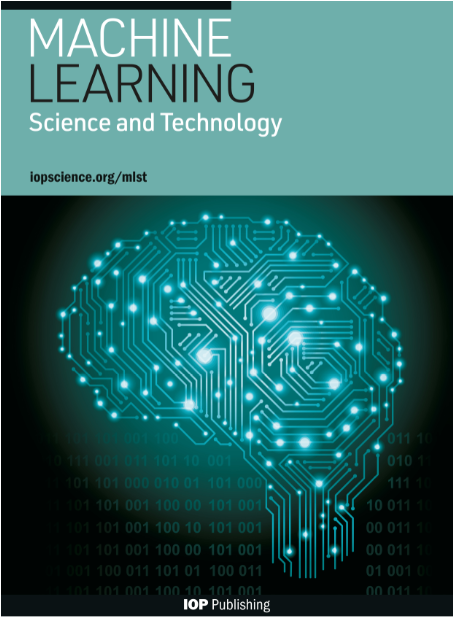Editorial board
Editor-in-Chief

Kyle Cranmer, University of Wisconsin-Madison, USA
Particle physics, machine learning, statistics, open science, cyberinfrastructure, and science communication.
Kyle Cranmer is a Professor of Physics, Statistics, and Computer Science and the Director of the Data Science Institute at the University of Wisconsin-Madison. Previously, he was a Professor of Physics and Data Science at New York University. Professor Cranmer obtained his Ph.D. in Physics from the University of Wisconsin-Madison in 2005 and his B.A. in Mathematics and Physics from Rice University. He was awarded the Presidential Early Career Award for Science and Engineering in 2007, the National Science Foundation’s Career Award in 2009, and became a Fellow of the American Physical Society in 2021 for his work at the Large Hadron Collider. Professor Cranmer developed a framework that enables collaborative statistical modeling, which was used extensively for the discovery of the Higgs boson in 2012. His current interests are at the intersection of physics, statistics, and machine learning.
Editorial Board
Alán Aspuru-Guzik, University of Toronto, Canada
Machine learning methods for inverse molecular design, generative models for molecules, Bayesian methods for experimental design, self-driving robotic systems for chemistry, quantum machine learning.
Anouar Benali, Argonne National Laboratory, IL, USA
Quantum Monte Carlo, Computational Material Science, Quantum Chemistry, Electronic Structure, Many-body theory
Tristan Bereau, Heidelberg University, Germany
Multiscale modelling and machine learning for soft matter and biomolecular systems.
Adrian Bevan, Queen Mary University of London, UK
Machine learning as applied to big data-based experiments, with particular focus on parameter estimation through complex modelling and simulation of data.
Keith Butler, Queen Mary University of London, UK
Machine learning and simulation to accelerate materials design and characterisation
Giuseppe Carleo, École polytechnique fédérale de Lausanne, Switzerland
Machine learning as applied to strongly interacting quantum systems, condensed matter, ultracold atoms, quantum computing, quantum Monte Carlo, neural-network quantum states, big data-based experiments.
Lucy Colwell, University of Cambridge, UK
Machine learning methods applied to biomolecular systems, computational chemistry and molecular design, with a particular interest in approaches that address structure and bias in chemical and biochemical data.
Clémence Corminboeuf, Ecole polytechnique fédérale de Lausanne, Switzerland
Electronic structure methods, computational chemistry and machine learning applied to molecular design, organic electronics and catalysis.
Gábor Csányi, University of Cambridge, UK
Atomistic simulation, multiscale modelling, molecular dynamics and applications of machine learning techniques to materials modelling problems.
Elena Cuoco, European Gravitational Observatory, Cascina, Italy
Machine learning and data analysis applied to gravitational wave detectors (Virgo and LIGO) including noise analysis and development of algorithms for data conditioning and signal detection.
Heather Gray, University of California, Berkeley, CA, USA and Lawrence Berkeley National Laboratory, CA, USA
Experimental particle physics (ATLAS) and applications of machine learning including the development of track reconstruction algorithms, silicon detectors, quantum computers and studies of the interactions of the Higgs boson to quarks.
Jim Halverson, Northeastern University, Boston, MA, USA
Theoretical high energy physics with a focus on the interfaces between particle physics and cosmology, superstring theory, pure mathematics, and applications of data science/machine learning.
Thomas Hammerschmidt, Ruhr University Bochum, Germany
Computational materials science, coarse-grained electronic structure methods, electronic-structure based descriptors for machine-learning, material informatics with structure maps.
Shirley Ho, Flatiron Institute, New York, USA
Machine learning and statistics in cosmology, theoretical astrophysics, observational astronomy, data science.
Olexandr Isayev, Carnegie Mellon University, USA
Machine learning for drug discovery, neural networks and quantum chemistry, machine learning for molecular and materials science, reinforcement learning and generative models.
Eun-Ah Kim, Cornell University, Ithaca, NY, USA
Condensed matter theory of strongly correlated systems including high temperature superconductivity, quantum criticality and topological phases. Applications of machine learning to simulated data and experimental data of quantum matter.
Roman Krems, University of British Columbia, Canada
Quantum dynamics, Bayesian machine learning, inverse problems in quantum mechanics, quantum machine learning, AMO physics, scattering theory, chemical reaction dynamics.
Sven Krippendorf, LMU Munich, Germany
Machine Learning for theoretical high energy physics and mathematical physics, ML for cosmology. Neural networks as physical systems.
Lucas Lamata, Universidad de Sevilla, Seville, Spain
Quantum machine intelligence, quantum information, quantum simulation, quantum optics, quantum control and quantum biomimetics.
Alpha Lee, University of Cambridge, United Kingdom
Statistical physics and soft condensed matter, with a particular focus on integrating physics, statistics and machine learning
Youzuo Lin, Los Alamos National Laboratory, NM, USA
Machine learning and computational methods, and their applications to geophysical measurements (including seismic, hydraulic and remotely sensed imagery), signal and image analysis, and computational methods for solving large-scale optimization and inverse problems.
Teruyasu Mizoguchi, The University of Tokyo, Japan
First principles simulation of functional materials, transmission electron microscopy, core-loss spectroscopy, machine learning and materials informatics.
Eric Mjolsness, University of California Irvine, CA, USA
Developmental systems biology, machine learning for multiscale science, mathematical artificial intelligence and computational biology.
Frank Noé, Freie Universität Berlin, Germany
Development of Machine learning and Computational Statistics methods for physics and chemistry, in particular with application to biophysics, biochemistry and cell biology.
Maurizio Pierini, CERN, Geneva, Switzerland
High energy particle physics, machine learning and data analysis applied to large detectors.
Stefan Scheel, University of Rostock, Germany
Quantum optics of macroscopic systems, photonics, Rydberg physics, ultracold atoms and quantum tomography.
Matthias Troyer, Microsoft Quantum, Redmond, WA, USA
Development of simulation algorithms for quantum many body systems and the investigation of quantum phase transitions, strongly correlated materials, ultracold atomic gases and quantum devices. Quantum computer architecture, algorithms and applications.
Mark Tuckerman, New York University, NY, USA
Statistical mechanics; enhanced sampling and machine learning of high-dimensional free energy surfaces; crystal structure prediction; machine learning in quantum chemistry.
Rama K Vasudevan, Oak Ridge National Laboratory, TN, USA
Data analytics and machine learning methods applied to materials science and condensed matter physics, specialising in complex oxides and the use of imaging and spectroscopic techniques to study systems at the mesoscopic and atomic level.
Anatole von Lilienfeld, University of Toronto, Canada and TU Berlin, Germany
First principles-based sampling of chemical compound space using quantum mechanics, supercomputers, Big Data, and machine learning. Pseudopotentials, van der Waals forces, density functional theory, molecular dynamics, and nuclear quantum effects.
David Wales, University of Cambridge, UK
Applications of energy landscape theory and machine learning to healthcare and molecular science, including mesoscopic structures, biomolecules, clusters and glasses.
Ge Wang, Rensselaer Polytechnic Institute, Troy, NY, USA
Machine learning theory, methods and applications with an emphasis on medical physics, including x-ray tomography, magnetic resonance imaging, optical tomography, multimodality imaging, and proton therapy.
Lei Wang, Institute of Physics, Chinese Academy of Sciences, China
Machine Intelligence – Deep learning and its application in scientific discoveries. Quantum Computing – Quantum algorithms and programming techniques. Algorithmic Design – Design new efficient algorithms for strongly correlated quantum matter.
Yi-Zhuang You, University of California San Diego, CA, USA
Theoretical condensed matter physics, strongly correlated systems, topological quantum phases of matter, many-body localization and thermalization, entanglement, tensor networks, holographic principles and machine learning.
Lenka Zdeborová, École polytechnique fédérale de Lausanne, Switzerland
Statistical physics of computational problems and algorithms, statistical inference, theory of deep learning, statistical learning theory, physics of disordered and complex systems, computational hardness and phase transitions.
Hui Zhai, Tsinghua University, China
Low temperature atomic physics, topological quantum matter, quantum simulation with cold atoms in optical lattices, applications of machine learning methods.
